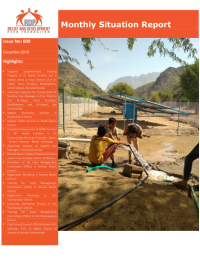Yemen: Monthly Situation Report No. 9 (December 2018)
Highlights:
- Targeted Supplementary Feeding Program in 52 health facilities and 8 mobile clinics in Four Districts (Far AlUdayn, Hazm Al-Udayn, Mudhiakhera, and Al-Udayn), Ibb Governorate.
- Awareness Sessions for Crucial Health & Nutrition Key Messages in Four Districts (Far Al-Udayn, Hazm Al-Udayn, Mudhiakhera, and Al-Udayn), Ibb Governorate.
- Regular Nutritional Services in Mudhiakhera District
- Regular Health Services in Mudhiakhera District.
- Completed Assessment of WASH Services in 187 Health Facilities in Six Governorates (Amanat Al Asimah – Sana’a – Amran – Dhamar – Marib – Al Bayda).
- Awareness Sessions on Hygiene Key Messages in Six Governorates.
- Rehabilitation of Water Scheme (Al-hasha well) in Fara Al-Udayn District of Ibb Gov.
- Formation of Six Food Management Committees (FMCs) in Dimnat Khadir District.
- Registration Workshop in Dimnat Khadir District.
- Training for Food Management Committees (FMCs) in Dimnat Khadir District.
- Registration Workshop in Ash Shamayatayn District.
- Launching Verification Process in Ash Shamayatayn District.
- Training for Food Management Committees (FMCs) in Ash Shamayatayn District.
- Psychosocial Support (PSS) Activities in AlQairawan Park, As Sabain District of Amanat Al-Asimah Governorate.
Humanitarian Context
In the two weeks preceding the ceasefire agreement in mid-December, there were intermittent armed clashes and artillery exchange in several areas in and around Al Hudaydah City.
Airstrikes continued sporadically in several locations including near the Al Mina, Bajil and Sukhnah, and in Ad Durayhimi and At Tuhayat districts. In Hajjah Governorate, armed clashes continued in Haradh and Hayran districts. According to the Protection Cluster, there were 114 civilian casualties in the reporting period, 35 of them fatalities. Damage was reported to houses, farms, businesses, mosques and water infrastructure.
Ongoing hostilities remain the main driver of worsening food security, IDPs and those hosting them are the most vulnerable. People at risk of starvation are in Hajjah, Al Hudaydah, Sa’ada and Taizz Governorates. The economic crisis and resulting high food prices, disrupted livelihoods and high levels of unemployment also affects those not in conflict areas – the cost of the minimum/survival food basket is 150 per cent higher than before the conflict.
As a result, a large number of households in most districts across the country are forced to engage in negative coping strategies, including reducing the number of meals or size of food portions, consuming less preferred foods and prioritizing children’s consumption. In addition, households have also resorted to practices that will undermine their longer-term food security, such as selling animals and household items.
According to the Protection Cluster, hostilities continued in the main conflict areas on the western and eastern outskirts of Taizz City, in Maqbanah in the northwest, and in the southeastern border districts of Hayfan and AlSilw. In Damt District, on the eastern side of Ibb Governorate, armed clashes continued reportedly causing the displacement of civilians to various governorates and within Ibb.
https://reliefweb.int/report/yemen/yemen-monthly-situation-report-no-9-december-2018


